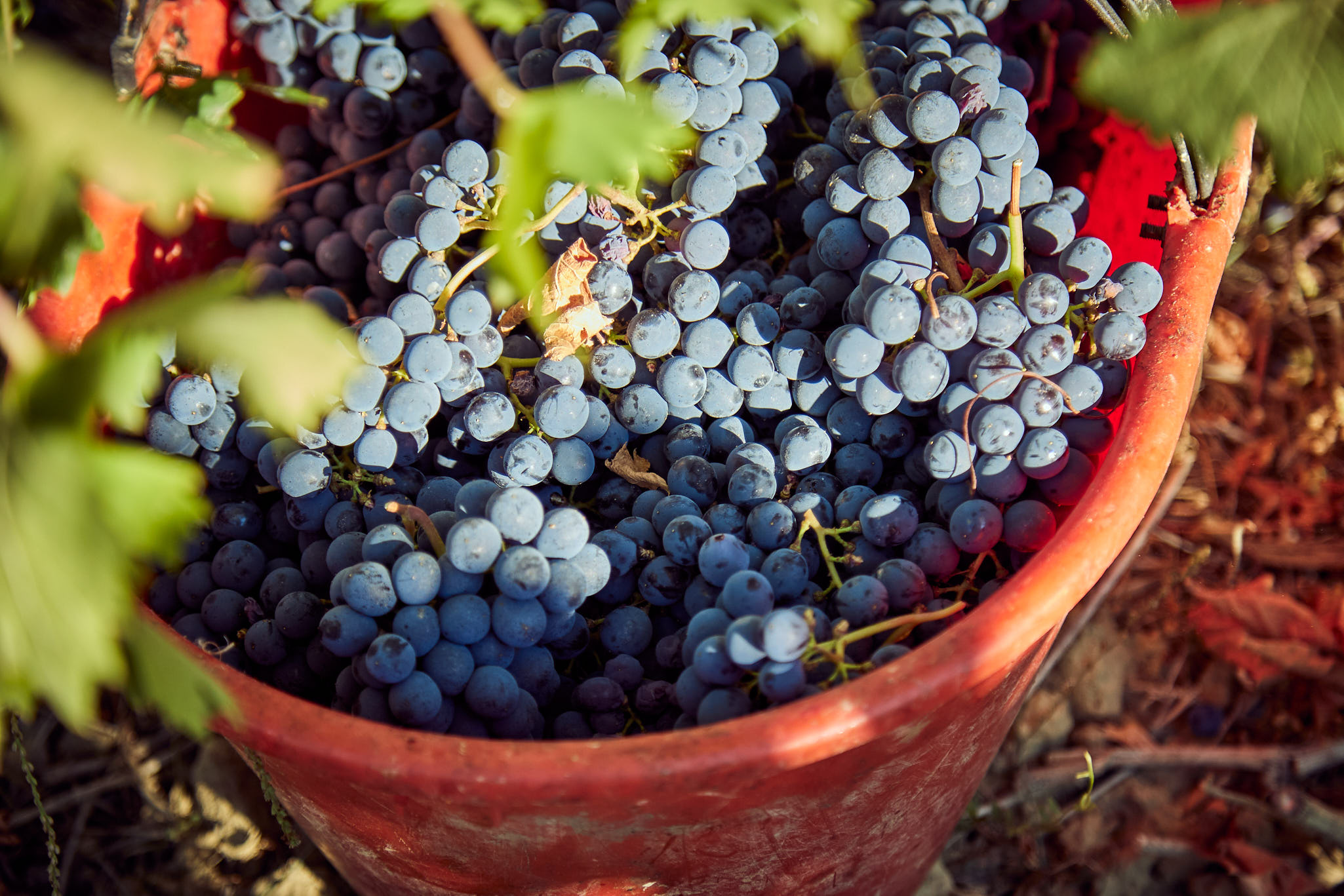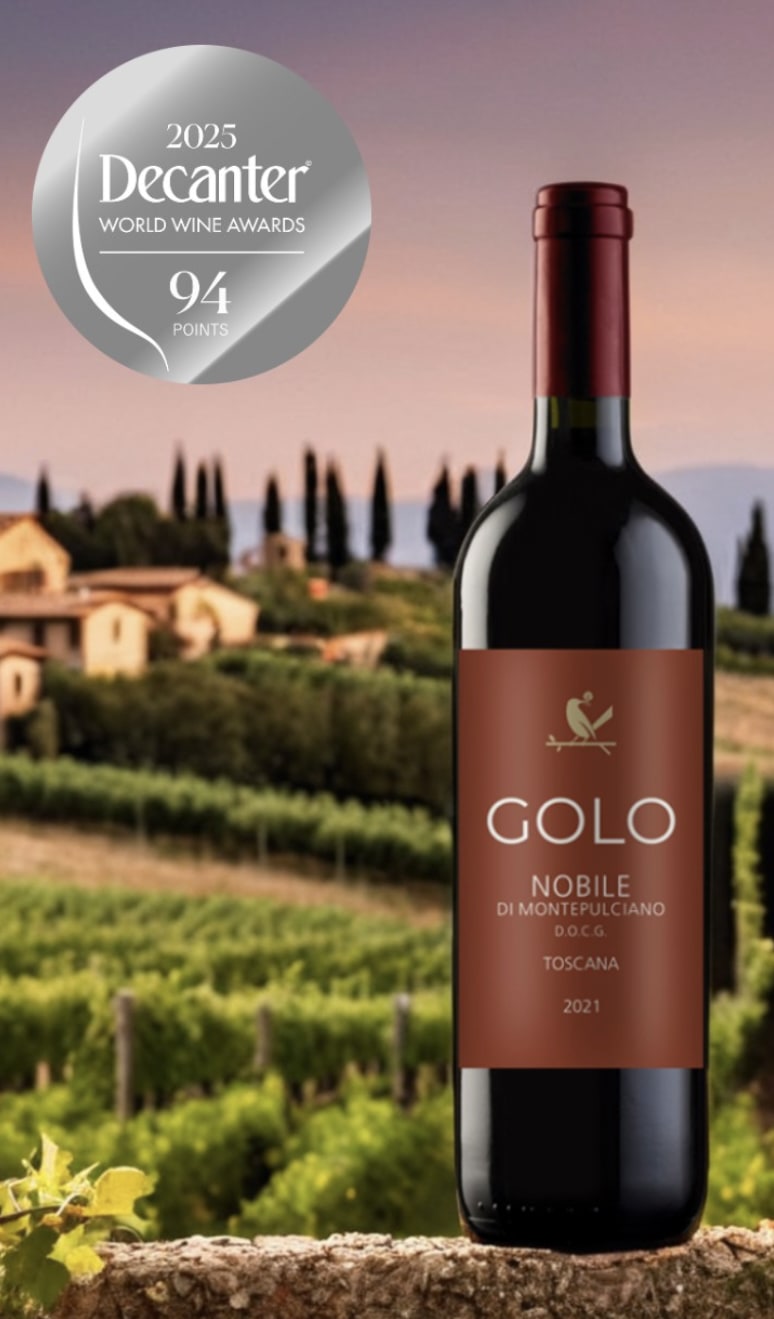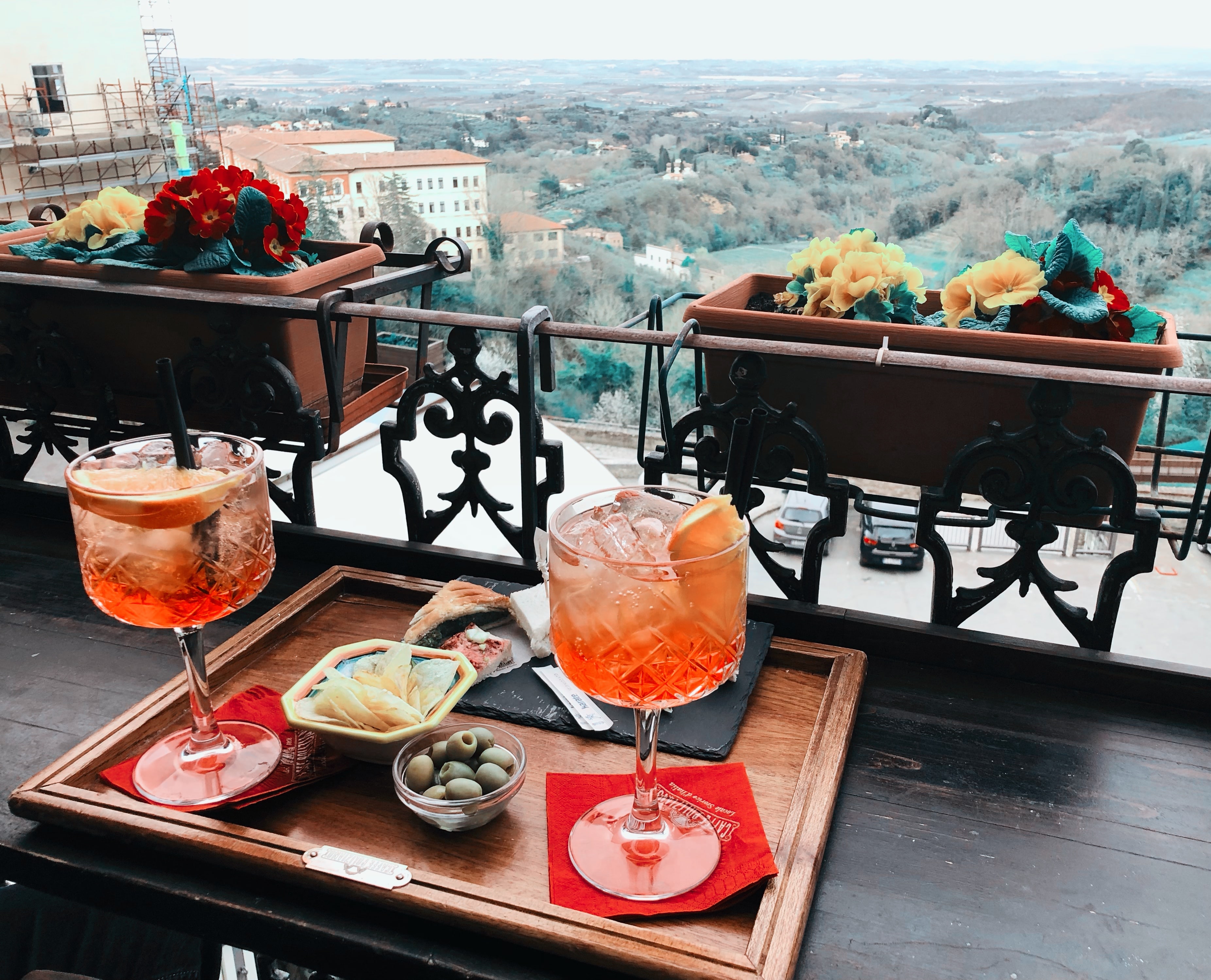Vino Nobile di Montepulciano Guide: Discover Tuscany’s Gem 2025
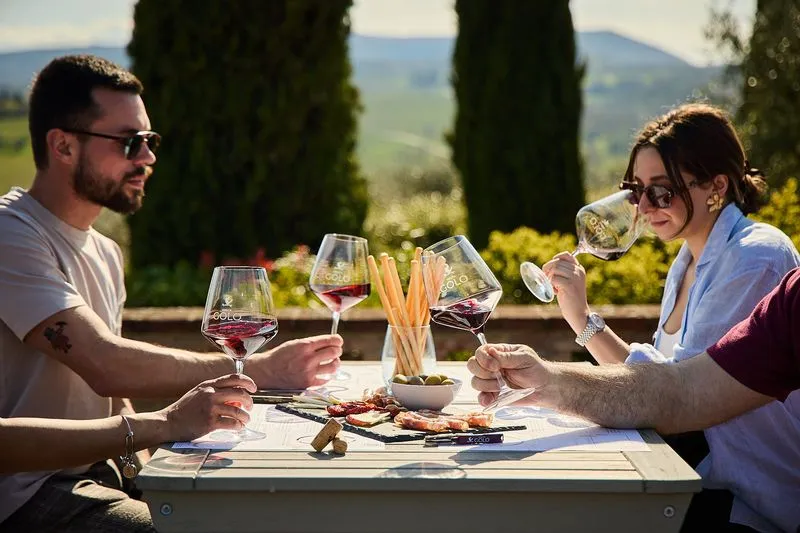
Embark on a journey through the rolling hills of Tuscany and uncover the magic of vino nobile di montepulciano, a wine celebrated for its elegance and rich heritage. This comprehensive guide will reveal everything you need to know about this esteemed Tuscan classic in 2025, from its ancient origins and unique production methods to tasting insights and expert travel tips. Discover the stories, savor the flavors, and be inspired to experience the noble charm of Montepulciano for yourself.
The Legacy of Vino Nobile di Montepulciano: History & Heritage
Journeying into the story of vino nobile di montepulciano is like opening a living history book of Tuscany. This wine is not only a product of the land but also a testament to centuries of tradition, noble patronage, and cultural pride. Its legacy is woven through ancient records, poetic tributes, and the enduring spirit of Montepulciano’s people.

Ancient Roots and Early Mentions
The roots of vino nobile di montepulciano trace back to at least 789 AD, when vineyard cultivation was first documented in the area. Over the centuries, the wine earned praise from poets and nobles alike. Francesco Redi famously crowned it the “king of all wines” in his 1685 ode, solidifying its reputation among the elite.
Trade records from the Middle Ages reveal that vino nobile di montepulciano was exported beyond Tuscany, valued for its quality and character. The town itself became synonymous with fine winemaking, contributing to the broader legacy of Tuscan viticulture. It is crucial to note that vino nobile di montepulciano is distinct from Montepulciano d’Abruzzo, which hails from a different region and grape variety.
For a deeper dive into the fascinating past and evolution of this noble wine, explore this detailed Vino Nobile di Montepulciano history.
The Rise to Nobility and DOCG Status
The journey to becoming “Nobile” began in the early 20th century, when Adamo Fanetti popularized the term to distinguish the wine’s superior quality. Previously known as “vino rosso scelto di Montepulciano,” the name change marked a turning point in its prestige and market presence.
In 1966, vino nobile di montepulciano achieved official DOC status, a recognition of its unique character and regional importance. This was elevated to DOCG in 1980, signifying the highest standard in Italian wine law. The founding of the Vecchia Cantina di Montepulciano in 1937 played a vital role, empowering small producers and consolidating local efforts.
After World War II, the wine’s reputation grew internationally, with exports increasing and global appreciation rising. This period cemented its status as a symbol of noble heritage and excellence in Italian winemaking.
Montepulciano Today: A Living Tradition
Today, the tradition of crafting vino nobile di montepulciano thrives alongside innovation. Producers honor time-honored methods while embracing new techniques, ensuring the wine’s continued relevance and quality. Local festivals celebrate the wine’s deep roots, and its presence is central to Montepulciano’s cultural identity.
The economic impact is profound, with wine tourism and production supporting the region’s prosperity. Vino nobile di montepulciano consistently ranks among Italy’s most prestigious reds, earning accolades and international awards for quality and distinction.
The legacy continues to evolve, inviting new generations to experience a wine that is both a reflection of the past and a beacon for the future.
Terroir and Grape Varieties: What Makes Vino Nobile Unique
Tuscany’s Montepulciano region offers a landscape shaped by centuries of winemaking tradition and natural beauty. The unique terroir and carefully selected grape varieties are at the heart of what sets vino nobile di montepulciano apart from other Italian reds. Each vineyard plot, grape, and farming practice contributes to the wine’s unmistakable identity.
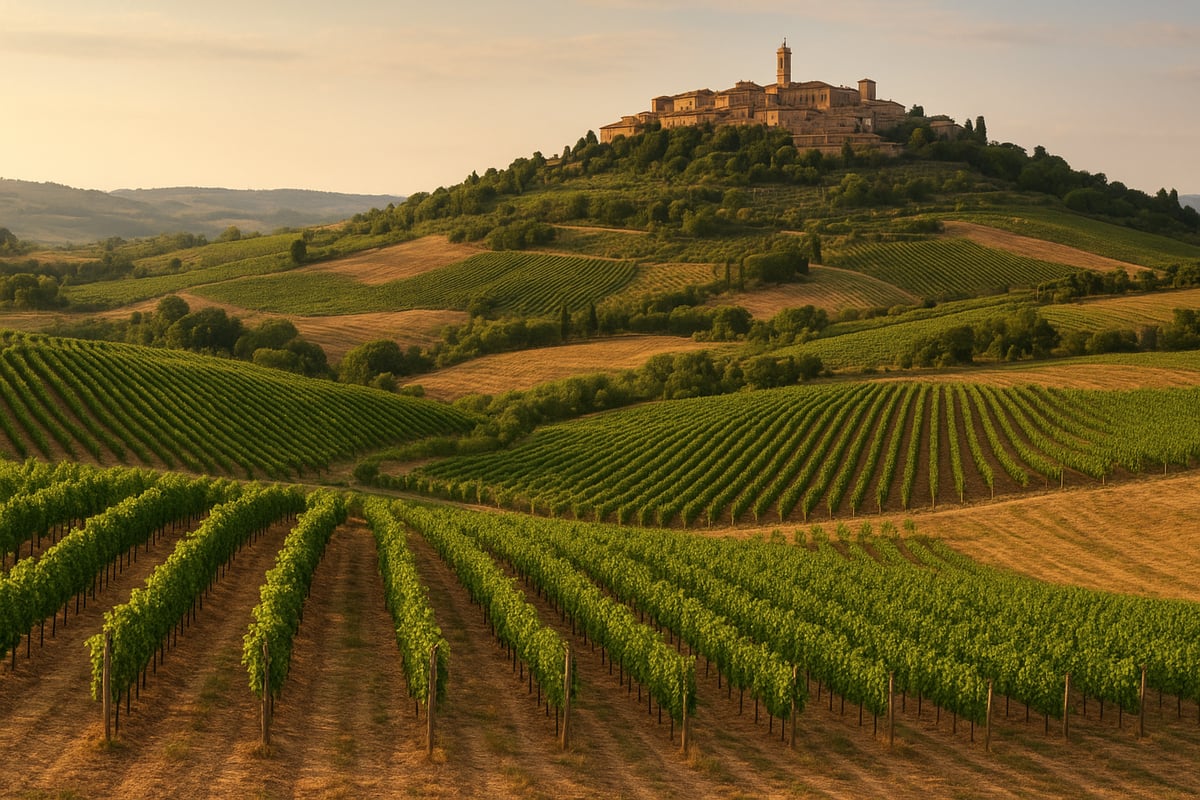
The Montepulciano Landscape
The vineyards of Montepulciano are nestled among rolling hills that rise between 250 and 600 meters above sea level. These elevations play a crucial role in shaping the flavors and structure of vino nobile di montepulciano. Higher plots benefit from cooler temperatures, which help preserve acidity and freshness in the grapes.
The soils are a mosaic of clay, sand, and silt. Clay-rich areas lend structure and depth, while sandy soils contribute elegance and aromatic lift. The Orcia and Chiana rivers influence the microclimate, providing natural irrigation and moderating temperature extremes.
Distinct seasons and ample sunshine create ideal ripening conditions. The region’s unique geography provides protection from harsh weather and allows for slow, even maturation. All these elements combine to foster the complexity and balance that define vino nobile di montepulciano.
The Grapes: Prugnolo Gentile and Friends
At the core of vino nobile di montepulciano is Prugnolo Gentile, the local name for a special Sangiovese clone. By regulation, at least 70% of the blend must be Prugnolo Gentile, prized for its vibrant acidity, cherry and plum notes, and refined tannins. This grape gives the wine its backbone and signature character.
To add complexity, winemakers blend in Canaiolo Nero (10–20%) and smaller amounts of indigenous varieties like Mammolo. These grapes contribute nuances of floral aroma, spice, and color. Strict rules ensure that only grapes grown within the Montepulciano area are used, preserving the wine’s authenticity.
For a deeper dive into the grape characteristics and blending styles that shape this wine, explore the Vino Nobile di Montepulciano wine details.
Sustainable Practices and Modern Trends
Producers in Montepulciano are increasingly embracing organic and biodynamic viticulture. This movement reflects a commitment to environmental stewardship and the long-term health of the region. Estates like Avignonesi and Salcheto are known for their pioneering efforts in sustainable farming.
Climate change has prompted adaptation, from canopy management to careful timing of harvests, ensuring that vino nobile di montepulciano maintains its hallmark balance. Winemakers blend tradition with innovation by using both time-honored and modern techniques in vineyard and cellar.
As a result, the wines offer purity, expression, and a sense of place. Sustainable practices not only protect the land but also enhance the quality and longevity of vino nobile di montepulciano.
The Art of Production: From Vineyard to Glass
The journey of vino nobile di montepulciano from vineyard to glass is a testament to careful craftsmanship and centuries-old tradition. Every bottle reflects the unique terroir, rigorous standards, and a blend of heritage with innovation that defines this Tuscan classic.
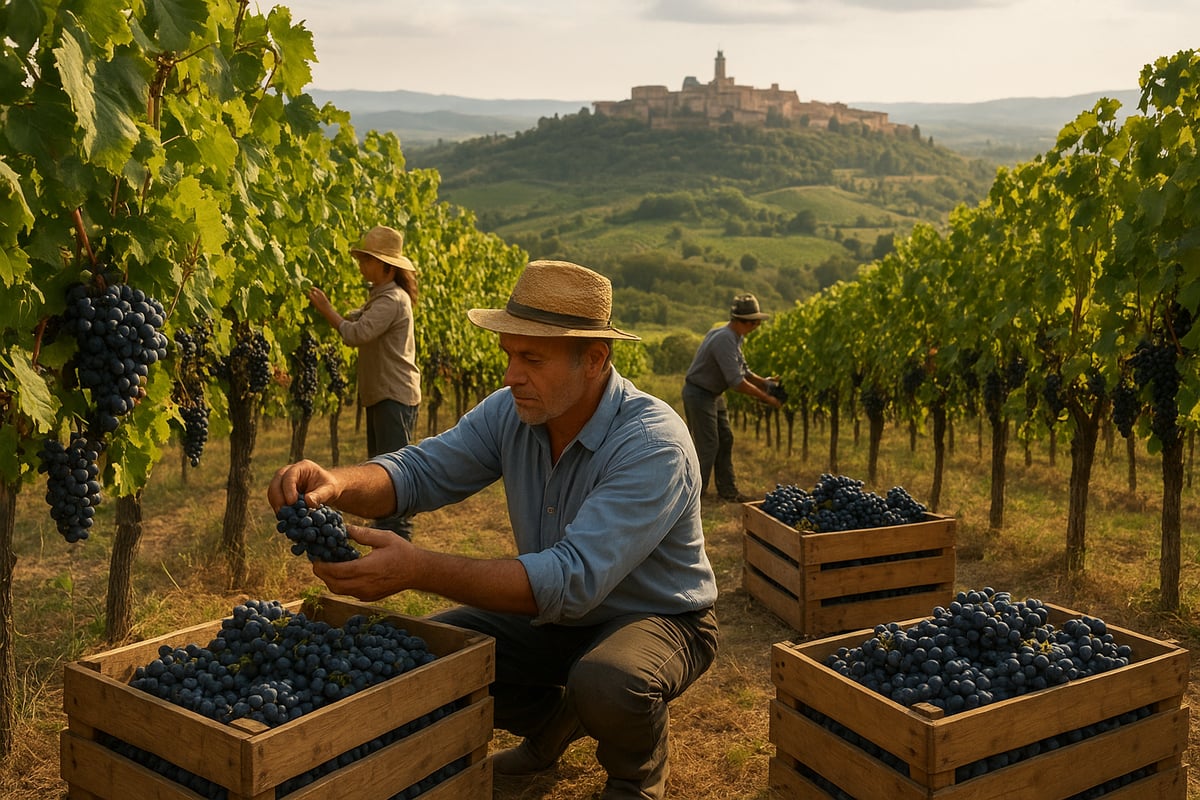
Harvest and Vinification
Harvest marks the first critical step in the creation of vino nobile di montepulciano. Grapes are often hand-picked at optimal ripeness, ensuring only the best fruit reaches the cellar. This practice preserves the integrity of Prugnolo Gentile and supporting varieties, protecting delicate skins and preventing premature oxidation.
After harvest, clusters are carefully sorted to remove any imperfect grapes. Destemming follows, separating berries from stems for a purer must. Fermentation is typically carried out in temperature-controlled stainless steel tanks, though some producers still favor traditional large oak vats. This stage is crucial for extracting color, tannins, and the vibrant aromas that characterize vino nobile di montepulciano.
Maceration, where juice remains in contact with grape skins, allows for deeper color and complexity. Temperature management during fermentation preserves freshness and balances structure. These meticulous choices at every stage influence the final style and quality of the wine.
Aging Requirements and Techniques
Aging is fundamental to the identity of vino nobile di montepulciano. By DOCG regulation, the wine must mature for a minimum of two years, with at least one year spent in oak barrels. Riserva bottlings require three years of aging, deepening their concentration and complexity.
Producers use a mix of large Slavonian oak casks and smaller French barriques. Large casks impart subtle spice and help maintain the wine’s fruit-driven profile, while barriques can add layers of vanilla, toast, and structure. Bottle aging prior to release allows the wine’s tannins and flavors to integrate fully.
The influence of oak and aging time shapes the texture and aromatic profile. Over time, fresh fruit and floral notes evolve into hints of dried herbs, leather, and tobacco, giving aged vino nobile di montepulciano remarkable depth and elegance.
Key Styles: Standard, Riserva, and Beyond
Vino nobile di montepulciano comes in several distinctive styles, each offering a unique tasting experience. The classic version delivers elegance, balance, and approachability, making it a favorite for both new and experienced enthusiasts.
Riserva represents the pinnacle of the category, crafted from the best grapes and aged longer for greater depth and aging potential. Rosso di Montepulciano, meanwhile, is a lighter, fruit-forward sibling with a shorter maturation period, ideal for immediate enjoyment. Novello and other local expressions provide even more diversity within the appellation.
When comparing vino nobile di montepulciano to other Tuscan reds, its signature lies in the harmony between structure, acidity, and a distinct sense of place. Each style is shaped by vineyard practices, blending decisions, and aging regimes.
| Style | Aging Minimum | Characteristics |
|---|---|---|
| Standard | 2 years (1 in oak) | Elegant, balanced, approachable |
| Riserva | 3 years (1 in oak) | Deeper, complex, age-worthy |
| Rosso di Montepulciano | Few months | Fresh, fruity, lighter body |
Quality Control and DOCG Certification
Strict quality control underpins the reputation of vino nobile di montepulciano. The DOCG regulations limit vineyard yields, define the production area, and set minimum alcohol requirements. Each producer must submit their wine to official tasting panels that evaluate aroma, flavor, and overall typicity.
Certification is granted only to wines that meet these rigorous criteria. Bottles are marked with a numbered DOCG seal, guaranteeing authenticity and traceability. Labels also indicate whether the wine is a standard, Riserva, or single-vineyard selection.
The Consortium of Vino Nobile di Montepulciano plays a vital role in overseeing these standards and supporting both tradition and innovation. Thanks to such oversight, vino nobile di montepulciano consistently ranks among the most prestigious Italian red wines, upholding its global reputation for excellence.
Tasting Vino Nobile di Montepulciano: Flavor Profile & Expert Tips
Discovering vino nobile di montepulciano is an invitation to engage your senses and deepen your appreciation for Tuscany’s winemaking artistry. Whether you are savoring your first glass or exploring a new vintage, understanding its character and tasting techniques will enhance every experience.
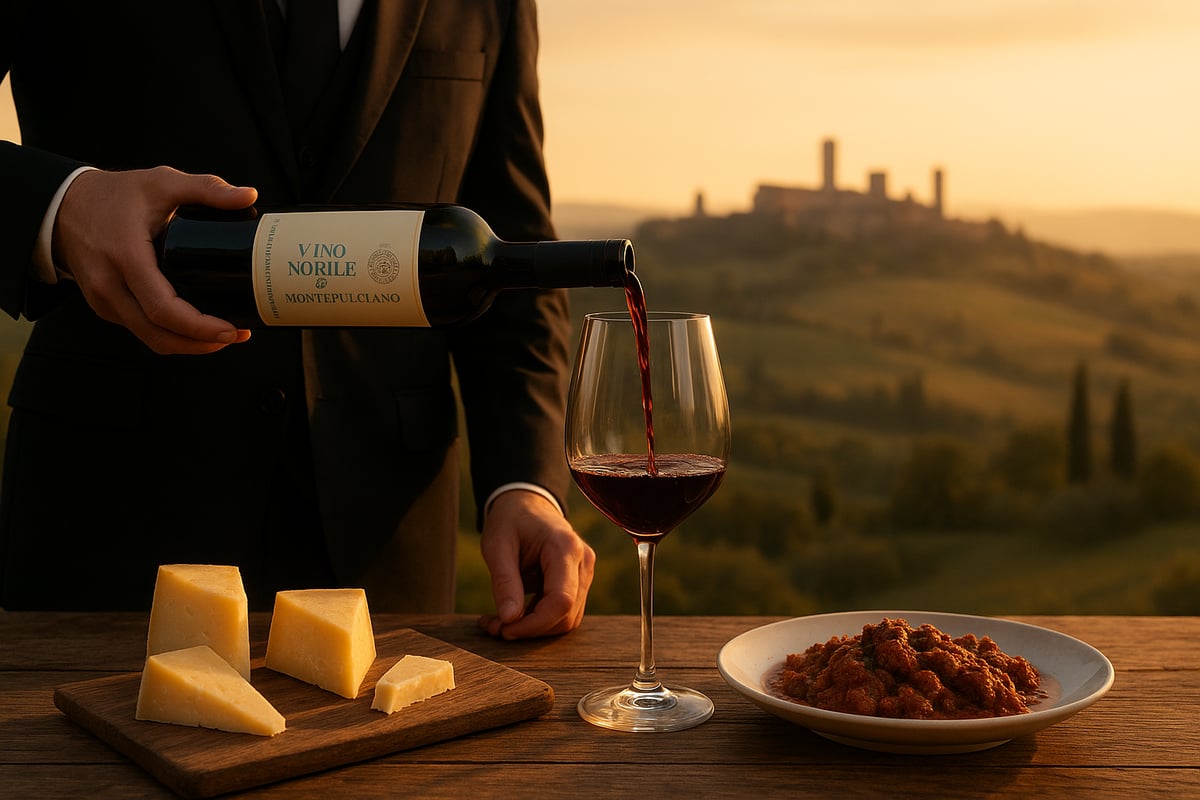
Appearance, Aroma, and Palate
The first impression of vino nobile di montepulciano is its deep ruby color, which gradually shifts to garnet hues as the wine matures. Swirl the glass and notice the clarity and intensity, both hallmarks of quality. On the nose, expect vibrant aromas of ripe cherry, plum, and violet, complemented by subtle earthy tones and a hint of spice. As the wine ages, notes of leather, tobacco, and dried herbs emerge, adding complexity.
On the palate, vino nobile di montepulciano offers a medium to full-bodied structure, with firm yet refined tannins. Its lively acidity brings freshness, balancing rich fruit flavors and savory undertones. For those seeking further detail on these characteristics, the Vino Nobile di Montepulciano overview provides an excellent foundation for understanding the wine’s unique sensory attributes.
Tasting Notes by Vintage (Recent Highlights)
Each vintage of vino nobile di montepulciano tells a unique story, shaped by the climate and producer’s touch. The 2018 vintage is celebrated for its balance and silky tannins, with estates like Fattoria del Cerro showcasing an elegant, lingering finish. Vintages from 2019 to 2021 are marked by bright fruit, freshness, and impressive structure, with notable examples from Dei, Poliziano, and Salcheto.
Top bottles can age gracefully for 10 to 20 years, developing greater depth and subtlety over time. Collectors and enthusiasts often seek out these standout years to experience the full evolution of vino nobile di montepulciano in their cellars.
How to Taste Like a Pro
To fully enjoy vino nobile di montepulciano, serve it at 16 to 18°C (60 to 64°F). Decanting younger wines for 30 to 60 minutes softens tannins and reveals aromatic layers. Use large, tulip-shaped glasses to concentrate the bouquet and highlight the wine’s complexity.
When tasting, observe the wine’s color against a white background, inhale deeply to capture its aromas, then take a small sip and let it linger on your palate. Producers such as Poliziano and Avignonesi are known for distinctive house styles, giving each tasting a unique signature.
Food Pairing Perfection
Vino nobile di montepulciano shines alongside classic Tuscan fare. Pair it with bistecca alla fiorentina, wild boar ragù, or aged pecorino cheese for a traditional experience. Its structure and acidity also complement tomato-based pastas, roasted vegetables, and hearty legumes.
For vegetarian or vegan pairings, try grilled eggplant, mushroom risotto, or lentil stew. The wine’s versatility makes it a delightful companion to a wide range of cuisines, inviting exploration and creativity with every meal.
Top Producers and Must-Try Bottles in 2025
The landscape of vino nobile di montepulciano is shaped by a blend of historic estates and innovative boutique wineries. In 2025, both tradition and creativity are thriving, offering wine enthusiasts a range of unforgettable bottles to discover. Let’s explore the producers and labels defining the excellence of vino nobile di montepulciano today.
Iconic Estates and Historic Wineries
When discussing vino nobile di montepulciano, several estates stand out for their enduring legacy and quality. Avignonesi is renowned for its organic approach and dedication to Prugnolo Gentile, producing wines with remarkable purity and depth. Poliziano brings a modern touch, consistently earning international recognition for its bold yet balanced expressions. Salcheto leads in sustainability, integrating innovative techniques that respect both the land and tradition. Fattoria del Cerro is one of the region’s largest estates, known for reliable quality and broad appeal. Dei, a family-run winery, captures the classic elegance of vino nobile di montepulciano through meticulous craftsmanship and a focus on terroir.
Boutique and Rising Stars
Beyond the iconic names, a new generation of small-batch producers is redefining vino nobile di montepulciano. These boutique wineries emphasize terroir-driven, artisanal wines, often working with limited parcels and traditional methods. Labels such as Boscarelli and Le Berne are gaining acclaim for expressive, nuanced bottles that highlight the region’s diversity. Many of these rising stars experiment with native varieties and sustainable farming, aiming to capture the authentic spirit of Montepulciano. As you explore vino nobile di montepulciano, seek out these lesser-known gems for a truly unique tasting experience.
Notable Bottles and Price Ranges
Vino nobile di montepulciano offers an impressive range of bottles to suit every palate and budget. Entry-level options, like Rosso di Montepulciano, are approachable and vibrant, often priced between €10 and €20. Classic vino nobile di montepulciano, typically found in the €20–€40 range, delivers excellent value and complexity. For collectors, Riserva or single-vineyard selections can range from €40 to over €100, showcasing profound depth and aging potential. Noteworthy vintages for 2025 include 2018 for its elegance and 2019 for structure and freshness. Each bottle tells a story of place, tradition, and innovation.
| Producer | Style | Price Range (€) | Notable Vintage |
|---|---|---|---|
| Avignonesi | Organic, classic | 25–80 | 2018, 2019 |
| Poliziano | Modern, structured | 20–100+ | 2019, 2020 |
| Salcheto | Sustainable, vibrant | 18–60 | 2018, 2021 |
| Dei | Elegant, traditional | 22–65 | 2019, 2020 |
Awards and Critical Acclaim
Recent years have seen vino nobile di montepulciano earn prestigious international awards, with critics praising both established estates and emerging producers. Top labels regularly receive high ratings for balance, depth, and longevity, reinforcing the wine’s reputation among Italy’s finest reds. Trends in global recognition highlight the region’s adaptability and commitment to quality, even as producers face new challenges. For further insight into how contemporary winemakers are innovating, see this overview of Vino Nobile production in the new normal. As the world’s palate evolves, vino nobile di montepulciano continues to shine on the international stage.
Experiencing Montepulciano: Wine Tourism & Travel Tips for 2025
Exploring the world of vino nobile di montepulciano is best done in its birthplace. Montepulciano offers a blend of history, wine, and Tuscan hospitality that enchants every visitor. Whether you are a wine enthusiast or a curious traveler, the town’s charm is unforgettable.
Planning Your Visit to Montepulciano
The ideal time to visit Montepulciano is during late spring or early autumn. These months offer pleasant weather, fewer crowds, and the excitement of harvest or local festivals. The town is accessible by car or train from Florence and Rome, with panoramic views as you approach.
Once in Montepulciano, immerse yourself in its medieval streets, Renaissance palaces, and scenic vistas over the Val d’Orcia. Planning ahead ensures you get the most from your trip, from winery appointments to cultural events. For more detailed travel advice and curated wine experiences, explore these Tuscan wine tourism tips.
Wine Tasting and Winery Tours
Vino nobile di montepulciano is at the heart of the region, and tasting it at the source is essential. Book winery visits in advance, especially during peak seasons, to secure a spot on guided tours. Many estates offer vineyard walks, cellar tours, and structured tastings.
Large producers provide polished experiences, while boutique wineries offer a more personal touch. Creating your own wine route allows you to sample a variety of styles and meet passionate winemakers. Each visit reveals a different side of vino nobile di montepulciano.
Immersive Experiences Beyond Wine
There is more to Montepulciano than vino nobile di montepulciano. Join a cooking class to learn traditional Tuscan recipes, or try truffle hunting in the surrounding woods. Local food markets brim with seasonal produce and regional specialties.
Visit olive oil estates for tastings and discover the area’s artisan cheeses and cured meats. Montepulciano’s museums, churches, and artisan workshops offer a deeper look into local culture and craftsmanship.
Where to Stay and Dine
Montepulciano offers a range of accommodations, from charming agriturismi to elegant boutique hotels and private villas. Many are set amid vineyards, offering stunning views and tranquil settings.
For dining, local restaurants serve classic Tuscan dishes that pair beautifully with vino nobile di montepulciano. Try pici pasta with wild boar ragù or pecorino cheese with honey. Ask for pairing recommendations to enhance your meal with the perfect glass.
Sustainable and Responsible Tourism
Support eco-friendly wineries and local businesses that prioritize sustainability. Many producers follow organic or biodynamic practices, reflecting a commitment to the land and community.
Respectful vineyard visits mean sticking to marked paths and following the guidance of hosts. Seek out opportunities to connect with the people behind the wine, and leave a positive impact on Montepulciano’s environment and economy.
Essential Buying Guide: How to Select, Store, and Serve Vino Nobile di Montepulciano
Navigating the world of vino nobile di montepulciano can be both exciting and rewarding. Whether you are searching for a memorable bottle to share or looking to build your collection, understanding how to select, store, and serve this Tuscan classic will elevate your experience. Let’s break down the essentials for every enthusiast.
Where to Buy: Local and International Options
Begin your search for authentic vino nobile di montepulciano in Montepulciano itself, where wine shops and estate tasting rooms offer direct access to the region’s top bottles. Many producers also ship internationally, and specialized online retailers feature a wide selection for global consumers.
When purchasing abroad, look for the DOCG label to ensure authenticity. The growing global demand for vino nobile di montepulciano reflects its economic impact and historical importance, making quality and provenance paramount. Always buy from reputable sources to guarantee the genuine article.
Choosing the Right Bottle
Understanding the label is key. Every bottle of vino nobile di montepulciano should display its vintage, producer, and classification—Riserva or single-vineyard selections offer unique expressions. Consider your taste preferences: do you favor youthful fruit, or the complexity of aged wines?
Refer to the price-to-quality ratio. Rosso di Montepulciano provides a lighter, more accessible entry point, while classic bottles and Riservas are suited for special occasions or aging.
Storage and Aging Potential
Proper storage is crucial for preserving the integrity of vino nobile di montepulciano. Keep bottles on their side, in a cool, dark place with stable humidity. The best wines age gracefully for 10 to 20 years, developing layered aromas and flavors over time.
Look for signs of aging potential, such as robust structure and acidity on the label or producer notes. Investing in a wine fridge or cellar can help maintain ideal conditions for long-term enjoyment.
Serving and Enjoyment Tips
To appreciate vino nobile di montepulciano at its best, serve it at 16–18°C in large, tulip-shaped glasses. Decant young bottles for about an hour to soften tannins and unlock aromas. Older vintages may need less aeration.
Here’s a quick reference table for serving:
| Wine Style | Decanting Time | Serving Temp (°C) |
|---|---|---|
| Young/Standard | 1 hour | 16–18 |
| Riserva/Older Vintages | 30 min | 18 |
| Rosso di Montepulciano | Optional | 15–17 |
Enjoy with classic Tuscan dishes or experiment with international cuisine for new pairings.
Collecting and Gifting Vino Nobile
Vino nobile di montepulciano is a smart addition to any wine cellar, prized for its aging capability and value. Bottles make thoughtful gifts for celebrations, weddings, or milestones.
For presentation, consider pairing the wine with local cheeses or artisanal accessories. Collectors appreciate the investment potential and rising recognition of top vintages—making each bottle a treasured part of your collection.
After exploring the remarkable heritage and flavors of Vino Nobile di Montepulciano, there is truly no substitute for experiencing it firsthand. Imagine wandering through sunlit vineyards, savoring expertly crafted wines, and feeling the rich history of Tuscany all around you. At Tenuta Golo, you can immerse yourself in both the beauty of the estate and the artistry behind every bottle. If you are ready to deepen your appreciation and create unforgettable memories in the heart of Montepulciano, I invite you to Book Your Wine Tasting Now.


